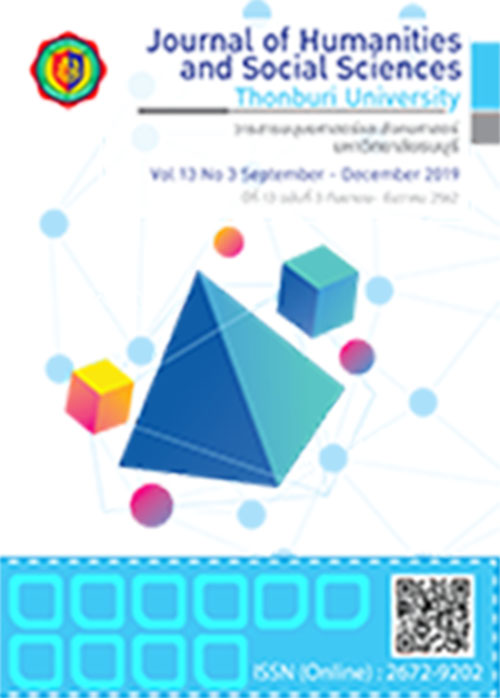THE MODEL OF STEM EDUCATION LEADER TEACHER DEVELOPMENT FOR THE SCHOOL UNDER CHIANG MAI PRIMARY EDUCATIONAL SERVICE AREA OFFICE 2
Keywords:
Research and Development, Model, Leadership Teacher Development, STEM EducationAbstract
The objectives of this research were to examine and analyze the STEM education teacher development process of the Institute for the Promotion of Teaching Science and Technology (IPST) and to develop the model and manual of the STEM Education Leader Teacher Development for the schools under the supervision of Chiang Mai Primary Education Service Area Office 2. The population was 614 science & technology and math teachers in the schools with 18 samples. The data collection concerned training STEM education teachers, an analysis of the environment and potential, a connoisseurship seminar, and an experimental implementation of the model and manual. The research instruments consisted of a basic comprehension test on STEM education, a qualitative behavioral observation, a structured interview, and a model and manual quality assessment. The findings are summarized as follows.
The research results are summarized as follows. 1) The analysis of the STEM education teacher development process revealed that there were three levels of drive. The first level was concerned with Office of the Basic Education Commission, IPST and related agencies. The second level involved regional STEM Education Center schools, mentoring universities and universities under the network of IPST. The third level consisted of educational area offices and schools. The problem found was that participating teachers were unable to create STEM education learning activity plans that were in line with their fields, contexts and potential of the students in their respective schools. 2) The development of the model and manual for the schools in the study area yielded the Leader Teacher STEM Model : LT STEM Model, which would enable the teachers to create STEM education learning activity plans in accordance with their fields, contexts and potential of the students in their respective schools. The mean of the quality assessment of the model and manual was 4.29 with the standard deviation of 0.69, deemed to be at a high level.
References
ชุฏิภัคศ์ เขมวิมุตติวงศ์. (2560). การวิจัยเชิงปฏิบัติการ: การพัฒนานักศึกษาออกแบบแผนกิจกรรมสะเต็มศึกษาโดยการเรียนรู้เชิงรุก. พิฆเนศวร์สาร. 13(2): 109-127.
พรทิพย์ ศิริภัทราชัย. (2556). STEM Education กับการพัฒนาทักษะในศตวรรษที่ 21. วารสารนักบริหาร. 33(2): 49-55.
พินิจ เนื่องภิรมย์. (2559). การประชุมวิชาการครุศาสตร์อุตสาหกรรมระดับชาติ ครั้งที่ 9. กรุงเทพฯ: มหาวิทยาลัยเทคโนโลยีพระจอมเกล้าพระนครเหนือ.
พิเศษ ปั้นรัตน์. (2556). เอกสารการอบรมแลกเปลี่ยนเรียนรู้ เรื่อง หลักและวิธีการจัดทำคู่มือปฏิบัติงาน. กรุงเทพฯ: มหาวิทยาลัยเกษตรศาสตร์.
สถาบันส่งเสริมการสอนวิทยาศาสตร์และเทคโนโลยี. (2557). คู่มือหลักสูตรอบรมครูสะเต็มศึกษา. กรุงเทพฯ: ศูนย์สะเต็มศึกษาแห่งชาติ.
สำนักงานเขตพื้นที่การศึกษาประถมศึกษาเชียงใหม่ เขต 2. (2560). รายงานผลการดำเนินงานประจำปีงบประมาณ 2560. เชียงใหม่: สำนักงานเขตพื้นที่การศึกษาประถมศึกษาเชียงใหม่ เขต 2.
อนุสรา สุวรรณวงศ์. (2559). ภาวะผู้นำเชิงนวัตกรรม (Innovative Leadership). กรุงเทพฯ: ทรูปลูกปัญญา.
Carol Kennedy. (2007). Guide to the Management Gurus. New York: BRILANTI.
Han, S. (2014). How Science, Technology, Engineering and Mathematics (STEM) Project-based Learning (PBL) affects High, Middle and Low Achievers Differently: The Impact of Student Factors on Achievement. Internation Journal of Science and Mathematics Education. 12(2): 1083-1113.
Horth, D. M., & Vehar, J. (2012). Becoming a Leader Who Fosters Innovation. (White Paper), Greensboro, NC: Center for Creative Leadership.
Keeves. (1997). Educational Research, Methodology, and Measurement. UK: Cambridge.
Peter, Senge. (1990). The fifth discipline: The art practice of the learning organization. New York: Doubleday.
Translated Thai References
Chiang Mai Primary Education Service Areas 2. (2017). Annual Report 2017. Chiang Mai: Chiang Mai Primary Education Service Areas 2. (in Thai)
Kemwimoottiwong, Chutipuk. (2017). Action Research: Student development for activities planning design of STEM Education with active learning. Journal of pikanasan. 13(2): 109-127. (in Thai)
Krajangsaeng, Kanokporn. (2560). The Role of Administrators and Team Building For The Organization Development. Journal of Thonburi University. 11(26): 156-161. (in Thai)
Nuangpirom, Pinit. (2016). The 9th National Conference on Technical Education. Bangkok: King mongkut,s university of technology north Bangkok. (in Thai)
Punrut, Phiset. (2013). Training materials is Principles and methods of preparation of operating manuals. Bangkok: Kasetsart university. (in Thai)
Siripatharachai, Porntip. (2013). STEM Education and 21st Century Skills Development. Executive Journal. 33(2): 49-55. (in Thai)
Suwanwong, Anutsara. (2016). Innovative Leadership. Bangkok: trueplookpanya. (in Thai)
The Institute for the Promotion of Teaching Science and Technology (IPST). (2014). Manual of the STEM Education Teacher Training Course. Bangkok : STEM Education Thailand. (in Thai)







